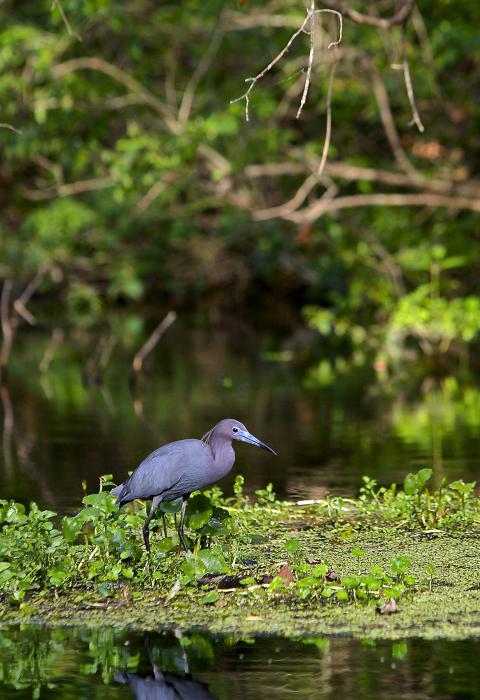Wekiva River
Florida
The Wekiva River Basin is a complex ecological system of rivers, springs, seepage areas, lakes, streams, sinkholes, wetland prairies, hardwood hammocks, pine flatwoods, and sand pine scrub communities. Water quality is exhibited in two ways. Several streams are clear due to being spring-fed. Others are blackwater; blackwater streams receive most of their flow from precipitation resulting in annual rainy season over-bank flows. The Wekiva and its tributaries are in superb ecological condition. The basin is almost entirely within Florida State lands and supports many species of plant and animal life, some of which are endangered, threatened, or of special concern. Elevations range from sea level to about 35 feet above sea level. The climate is subtropical, with an average annual temperature of around 72 degrees. Mean annual rainfall over the Wekiva basin is 52 inches, most of which occurs during the June-October rainy season.
Designated Reach
October 13, 2000. The Wekiva River from its confluence with the St. Johns River to Wekiwa Springs. Rock Springs Run from its headwaters at Rock Springs to the confluence with the Wekiva Springs Run. Black Water Creek from the outflow from Lake Norris to the confluence with the Wekiva River.
Outstandingly Remarkable Values
Ecology
The Wekiva River watershed is a mosaic of upland, wetland, and aquatic habitats at the southern end of an important wildlife corridor that connects the Wekiva Basin to the Ocala National Forest. An extensive floodplain of hardwood forest, as much as three miles wide, provides habitat for several species designated as endangered, threatened, or species of special concern. The Wekiva Basin is located at a transitional area between temperate and sub-tropical climatic zones. The species overlaps result in one of the richest floral compositions in Florida. Unusual plant species found in the Wekiva basin include red buckeye, chinquapin, and Carolina basswood, species more commonly associated with Appalachia.
Prehistory
Numerous archeological and history sites have been recorded in the general region. Remains of now extinct Pleistocene megafauna and large herd animals have been found with the distinctive fluted projectile points made by Paleo-Indians. The first major occupation of the St. Johns River Valley occurred during the Mount Taylor Period (6000–2000 BC). The Orange Period (2000–500 BC) marked the appearance of ceramics, an apparent increase in population size, sociopolitical complexity, and territorial range. The St. Johns Period (500 BC– AD1565) showed a continued preference for mound building, but the later part of the period was also marked by profound changes in Native American life, including European influences. Although central Florida was not occupied by Europeans during most of the Spanish-British period, Hernando DeSoto’s Florida expedition (1539-1540) marked the beginning of a steep decline in Native American populations in the state.
Recreation
The Wekiva River, Wekiwa Springs Run, Rock Springs Run, and Black Water Creek serve as a major nature-based recreational resource for central Florida, particularly for the large Orlando metropolitan area. Recreation activities in the Wekiva Basin include canoeing/kayaking, bank fishing, boat fishing from motor and nonmotorized boats, personal watercraft use, picnicking, camping (primitive, developed, and horse), tubing, swimming, snorkeling, wildlife watching, hiking, horseback riding, and hunting. The Wekiva River/Rock Springs Run Canoe Trail is officially designated as part of Florida’s statewide system of greenways and trails.
Scenery
The Wekiva River system is an exceptionally scenic resource, providing ample opportunities to explore, study, and appreciate nature. Many segments of the river systems are in near-pristine condition, offering the chance to experience an unspoiled part of natural Florida. The crystal clear waters of the springs and spring runs; the tannic dark water of tributaries; and the mosaic of natural communities surrounding the river system all contribute to this unique resource.
Wildlife
The river corridor’s diverse array of natural communities is home to a wide variety of wildlife species. For example, one of the state’s largest populations of Florida black bear, currently listed by the state of Florida as a threatened species, uses the protected riparian corridor and surrounding habitat to move between the Ocala National Forest and large patches of conservation lands that comprise the Wekiva-Ocala Greenway in Orange, Seminole, and Lake counties. The wood stork, a federally endangered species, nests in cypress trees within the Wekiva River Aquatic Preserve and is often observed foraging in the river shallows. The bald eagle, protected under the federal Bald and Golden Eagle Protection Act, can also be seen along the river system. The little blue heron, tri-colored heron, and limpkin are state species of special concern.
Documents
Classification/Mileage
Video
The Wekiva River and its tributaries were designated as a National Wild and Scenic River System in October 2000. The Wekiva River, Wekiwa Springs Run, Rock Springs Run, and Black Water Creek are included in this National Designation. The Wekiva River System is a Partnership Wild and Scenic River, managed by a consortium of local stakeholders called the Wekiva Wild and Scenic Management Committee.

